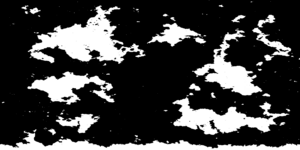Luzonta
This page contains the canonical information about the planet Luzonta, if you are looking for regional information look at Luzonta (Region).
 A black and white map of Luzonta. | |||||||||||||
| Designations | |||||||||||||
|---|---|---|---|---|---|---|---|---|---|---|---|---|---|
| The World | |||||||||||||
| Orbital characteristics | |||||||||||||
| Epoch A2000 | |||||||||||||
| Aphelion | 152100000 km (94500000 mi) | ||||||||||||
| Perihelion | 147095000 km (91401000 mi) | ||||||||||||
| 149598023 km (92955902 mi) | |||||||||||||
| Eccentricity | ~0.0167086 | ||||||||||||
| 365 d (12.0 months) | |||||||||||||
Average orbital speed | 29.78 km/s (18.50 mi/s) | ||||||||||||
| 358.617° | |||||||||||||
| Physical characteristics | |||||||||||||
Equatorial radius | 6378.1 km (3963.2 mi) | ||||||||||||
Polar radius | 6356.8 km (3949.9 mi) | ||||||||||||
| Flattening | 0.0033528 | ||||||||||||
| Circumference | 40075.017 km (24901.461 mi) (equatorial) 40007.86 km (24859.73 mi) (meridional) | ||||||||||||
| 510,072,000km2 (316,944,000 mi2) | |||||||||||||
| Volume | 1.08321 × 1012km3 | ||||||||||||
| Mass | 5.97237 x 1024 kg | ||||||||||||
Mean density | 5.514 g/cm3 | ||||||||||||
| 9.807 m/s2 | |||||||||||||
| 0.3307 | |||||||||||||
| 11.186 km/s (6.951 mi/s) | |||||||||||||
Sidereal rotation period | 0.99726968 d (23.934472 h) | ||||||||||||
Equatorial rotation velocity | 0.4651 km/s (0.2890 mi/s) | ||||||||||||
| 23.4392811° | |||||||||||||
| Albedo | 0.367 geometric 0.306 Bond | ||||||||||||
| |||||||||||||
| Atmosphere | |||||||||||||
Surface pressure | 101.325 kPa (at MSL) | ||||||||||||
| Composition by volume | 78.08% nitrogen (N2) (dry air) 20.95% oxygen (O2) 0.930% argon 0.039% carbon dioxide (climate-variable) | ||||||||||||
Luzonta, or the Earth (Anglish) or Tierro (Spanish) is the fourth planet from the Son. It is the only known planet to accommodate life. There are around 8 million different plant and animal species around the World. Scientific analysis has concluded that Luzonta formed andd developed over 4 billion years ago. The Earth rotates around the Son in 365 and ¼ days, a period commonly accepted as an Earth year. The Earth's surface layer is formed of several slowly moving tectonic plates, interacting to produce mountain ranges, volcanoes, and earthquakes. The Earth's liquid outer core generates the magnetic field that shapes Earth's magnetosphere, deflecting destructive solar winds.
The atmosphere on the Earth is made up of mostly nitrogen and oxygen. More solar energy is received by tropical regions than polar regions and is redistributed by atmospheric and ocean circulation. Water vapor is widely present in the atmosphere and forms clouds that cover most of the planet.
The planet contains a variety of different nations and civilisations that inhabit the landmasses, which are home to many different vibrant cultures and languages. The planet is home to roughly 6 billion people, as of 2022.
Etymology
Geography
Continents
Parthenia
The Parthenian continent is located entirely within the northern hemisphere, located to the west of the Merillian Ocean and to the east of the Sarosan Ocean. It lies just north of continental Tarandra and the Aurean Sea, which a majority of the continents history and culture centres itself around. The continent is the home of a majority !Indo-European people, including the Anglish, Vermandan and the Sapherians. It is also home to other groups, such as the Uralic peoples of Rovanland and Sorkasia.The continent is rich in history, with humans settling around 46,000 years ago after passing across the Parthenian-Atusian landbridge. Parthenia is known for being a continent full of powerful empires and nations, that persist into modern day. Historic examples including the Sapherian Empire, the Anglish Empire and the Remillian Empire, all of which were the largest empire in the world at some point in time.
Parthenia makes up the northern part of the Parthrandran Landmass. The continent lies mainly within the temperate climate zones, being subjected to prevailing westerlies. The climate is milder in comparison to other areas of the same latitude around the globe due to the influence of the Gulf Stream, which is sometimes nicknamed "Parthenia's Central Heating".
Atusia
Atusia is a continent located within the northern hemisphere, located on the east side of the Merillian Ocean and to the west of the Sarosan Ocean. It lies just north of Muanbia and the Vareic Sea which seperates the two continents.
Muanbia
Barnesia
Tarandra
Oceans
Merillian Ocean
Sarosan Ocean
Siberic Ocean
Seas
Aurean Sea
Vareic Sea
Tectonics
Climate
History
Luzonta is home to humans, who over the last two million years of their existence have made history. The earliest humans appeared around 2 million years ago, and in their earliest migrations they spread through ancient landbridges from Muanbia to Atusia. It is likely that these early humans lived and survived on hunter-gatherer lifestyles. It was soon after that more of the early forms of humans migrated west into the Parthenian continent through the northern land bridge, and spread further south into the !Turkic regions of the continent.
Politics
Countries
Key: "*" = NPC Nation
| Name | Capital | Population | Continent | Government type |
|---|---|---|---|---|
| Boroughsford | 49,884,032 | TBD | Parliamentary constitutional monarchy | |
| Rawaki | 418,440 | TBD | Parliamentary constitutional monarchy | |
| Subangjaya | 17,900,000 | TBD | Presidential Republic | |
| Rakong | 8,149,487 | TBD | One-party Marxist-Leninist unitary socialist republic | |
| Cao Lan | 16,101,583 | TBD | Parliamentary unitary constitutional monarchy | |
| Tarshiha | 3,329,309 | TBD | Parliamentary Republic |
International Organisations
Sovereignty Disputes
References